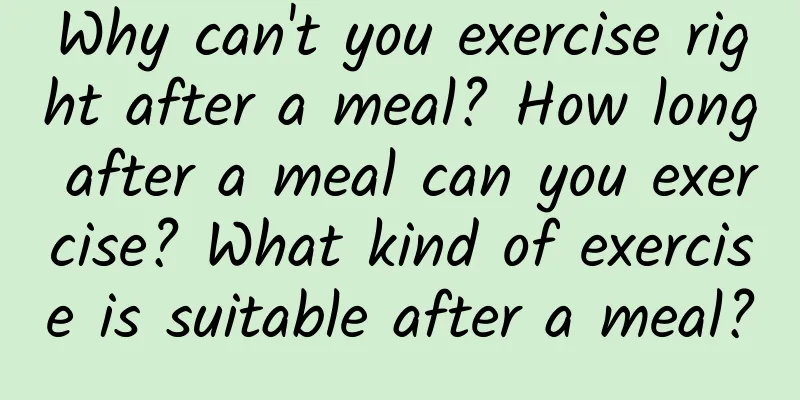Why can't you exercise right after a meal? How long after a meal can you exercise? What kind of exercise is suitable after a meal?

|
Whether to exercise after a meal depends on individual needs. For ordinary people, even if they need to take a walk after a meal, it is best to rest for a while before walking slowly. The amount of activity after a meal also varies from person to person, and it is best not to feel tired. Why can't you exercise right after a meal?It is not advisable to run or exercise after a meal, because the digestive organs need a lot of blood supply to work hard after a meal. If you run or exercise at this time, the skeletal muscles will inevitably rob a lot of blood, resulting in ischemia of the digestive tract, which will not only weaken the peristalsis of the gastrointestinal tract, but also significantly reduce the secretion of digestive juices, which will cause indigestion. Running or exercising after a meal can sometimes cause abdominal pain. Why is this? The reasons may be as follows: 1. After a meal, the stomach is full of food, and the gastrointestinal tract vibrates during exercise, causing the mesentery connecting the gastrointestinal tract to be stretched, causing abdominal pain. 2. During exercise, blood distribution shifts from the digestive tract to the skeletal muscles, causing ischemia in the digestive tract and leading to spasm of the gastrointestinal smooth muscles, thus causing abdominal pain. 3. During exercise, the body's oxygen demand increases. People who lack exercise usually have a small lung capacity, so when they try to breathe hard, they tend to breathe shallowly and quickly. This reduces the negative pressure in the chest cavity, causing blood return to the liver to be blocked, leading to liver congestion and increased tension in the liver capsule, causing liver pain, manifested as pain in the right upper abdomen. 4. Other gastrointestinal diseases, including appendicitis, occur when exercising after a meal. In the first three cases, the abdominal pain will soon subside after the exercise stops. The fourth case is an organic disease, the pain lasts longer than the first three, and most of them will gradually worsen. For this kind of abdominal pain, you should go to the hospital for diagnosis and treatment in time. How long after a meal can you exercise?The length of the interval between a meal and before exercise depends largely on the type of meal and the amount consumed. Other determining factors include age, physical condition, and exercise intensity. Assume that this reader is an average middle-aged person! If you eat a large amount of food before exercise, and most of it is high in protein and fat, the interval should be more than two hours. If the meal is small and mainly carbohydrates, the interval can be shortened to 30 minutes to 1 hour. Any change is best made gradually, but if any muscle or digestive problems occur, you have to stop. Generally speaking, people who do not exercise regularly and those who are weak are better off exercising 0.5 to 1 hour after a meal. Formal exercise and intense competition are best done 1.5 hours after a meal. Not doing intense exercise after a meal does not exclude doing light exercise after a meal. Everyone can do appropriate exercise according to their own conditions, such as walking or doing other light activities, which is still beneficial to improving health. What kind of exercise is suitable after a meal?Practice squats: Preparatory posture: Stand with your feet shoulder-width apart, arms hanging naturally, palms lightly placed on both sides of your legs, and eyes looking straight ahead. Action: Take a step to the left with your left leg, and at the same time, raise your arms to hold something, with your hands no higher than your shoulders, and look straight ahead. Bend your knees and squat about 130 degrees, keep steady, keep your upper body straight, and press your hands down to the same height as your navel. Keep the half-squat position for 15 seconds. When you feel soreness, numbness, or swelling in your lower limbs, stand up slowly and breathe naturally. Function: It can exercise the muscles of the lower limbs, waist and back, and relieve muscle tension. The above exercises should be carried out in accordance with the principle of gradual progress and moderation. Start with a small amount of exercise, and the heart rate after exercise should increase by 30% to 50% compared with that before exercise. Since the process of exercise is a process of gradual improvement and adaptation of functions, it takes a certain amount of time to adapt to the increase in exercise. Each exercise time is 20 to 40 minutes. Gradually increase from 2 to 3 days of exercise per week to 5 to 7 days. Using fitness equipment - Tai Chi Push Hands Device: Action: Face the machine, stand with your feet shoulder-width apart, bend your knees slightly, and stand in a horse stance. Open your hands and place them on the edges of the two turntables on the same side, and turn the turntables. During the exercise, when pushing to the right, the center of gravity below the waist should move to the right, and the right leg should be in a lunge. When pushing to the left, the center of gravity should move to the left, and the left leg should be in a lunge. Repeat this exercise. The exercise speed is medium, and the exercise time should be 3 to 5 minutes per exercise. Do it 2 to 4 times, depending on your own situation. Function: It can exercise the upper limb muscles, relieve arm muscle tension caused by writing, and promote gastrointestinal motility and facilitate digestion. When doing the above exercises, you should pay attention to gentle and even movements, and avoid using excessive force to avoid injury. Variable speed sports Generally speaking, the walking speed is 25-30 meters per minute for slow walking, 70-90 meters per minute for fast walking, which is equivalent to about 5 kilometers per hour, and 6-7 kilometers per hour for jogging. It is generally better to keep a constant speed, or you can use variable speed according to the terrain and ground structure. During exercise, the heart rate should be controlled at 110-130 beats per minute. Function: As an aerobic exercise, it can improve cardiopulmonary function and relax muscles. In addition, after lunch, find an open and flat place to practice Tai Chi, do deep leg stretches, or slowly press your back against the wall. The movements are not large, but they can relax the muscles and relieve muscle soreness caused by long-term sitting. Go barefoot Action: Choose a clean, smooth, cobblestone-paved path in the shade of the trees, and walk slowly barefoot on the cobblestone road. The best time is 30 minutes. Function: By increasing the contact opportunities between the plantar fascia, ligaments, acupoints and nerve endings and the uneven road surface, the sensitive areas of the soles of the feet are constantly stimulated. These stimulation signals are transmitted to the corresponding heart organs and the corresponding cerebral cortex, which can regulate the functions of various parts of the body and play a role in assisting the treatment of certain diseases. Is it okay to take a walk after dinner?In daily life, we often hear two different sayings. One is: Walk a hundred steps after a meal, and you will live to ninety-nine . The other is: If you want to live to ninety-nine, don't walk after a meal . On the surface, both seem to make sense, but they contradict each other, making people feel at a loss. Those who hold the view of "walking a hundred steps after a meal" believe that walking after a meal helps digestion and is therefore good for health. The reason for advocating "not walking after a meal" is that the food in the stomach needs to be digested after a meal, and the blood flows to the stomach at this time, while walking disperses the blood circulation and affects digestion, so it is not good for health. In fact, the two views are suitable for different groups of people. Walking 100 steps after a meal is suitable for people who are less active, especially those who work at a desk for a long time, and also for those who are overweight or have excessive gastric acid secretion. For these types of people, walking for more than 20 minutes after a meal can help them combine work and rest, reduce fat accumulation and gastric acid secretion, and benefit their health. Don't walk after meals, mainly refers to people with poor physical fitness, frail and sickly, especially those suffering from diseases such as gastroptosis. These people should not only not take a walk after meals, but also reduce general exercise. Instead, they should lie flat for 10 minutes after meals. This is because the stomach contents increase after meals. At this time, further movement will increase the vibration of the stomach, increase the burden on the stomach, and in severe cases, aggravate gastroptosis. In addition, patients with cardiovascular and cerebrovascular diseases, such as hypertension, should not exercise after meals. Because gastrointestinal activity increases after meals, blood circulation is disordered. It is worth noting that such patients are not suitable for bed rest after meals, so as to avoid accidents such as stroke due to insufficient blood supply to the brain when getting up. In summary, whether to exercise after a meal should vary from person to person. For ordinary people, even if you need to take a walk after a meal, it is best to rest for a while before walking slowly. The amount of activity after a meal should also vary from person to person, so as not to feel tired. |
<<: What causes yellow teeth? What to do? Tips on how to whiten teeth
Recommend
One in two people is infected! Bad breath caused by this bacteria is actually a sign of cancer?
Bad breath It can be called the biggest social ki...
Women's hands and feet swollen in the morning
Many people will experience symptoms such as swol...
Left eye twitching means good fortune, right eye twitching means disaster? Don't be superstitious, it's actually your body "warning"
“If your left eyelid twitches, good things are ab...
What should I do if there is a strange smell down there?
The odor in the private parts makes many women ve...
Is it good for a woman with small feet?
There are many viewpoints on a good life, and eve...
How long does it take for blood sugar to recover after giving birth?
Once women become pregnant, the hormones in their...
What can women eat to improve their immunity?
People with poor immunity will naturally have poo...
What are the advantages and disadvantages of smelling osmanthus? Types of osmanthus
In mid-autumn, osmanthus flowers are in full bloo...
What fruits are good for dysmenorrhea?
Dysmenorrhea can be said to be a problem that wom...
Is frequent urination a sign of imminent birth?
In the late stages of pregnancy, a woman's bo...
Consequences of recurrent fungal vaginitis
Due to the special physiological structure of fem...
Is it normal for women’s leucorrhea to appear milky white?
Leucorrhea is a unique physiological symptom of w...
Does menstruation mean ovulation?
As long as you are healthy and your menstrual cyc...
How to treat fallopian tube obstruction
In today's complex modern society, the incide...
Protect your feet health: foot care tips for patients with peripheral neuropathy
Author: Zheng Yongsheng, Xu Yafang, Zhang Mingjie...









